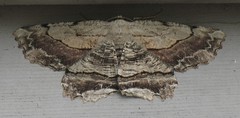Not nearly all I meant to do! When you work full-time and are in grad school part-time, every bit of free time seems like a resource to be used (possibly even "exploited"). Summer becomes a vast expanse of opportunity, not unlike the North American frontier during the 19th century. In that sense, I failed miserably, because the wild frontier is still there and the prairie dogs are snickering at me. But that may be a good thing.
I took lots of photos of moths, many of which may never be identified (or at least not identified for months to come). Keeping a moth list is a lesson in deferred satisfaction. Birders are used to being able to look the mystery bird up in our choice of field guides or reference tomes. Moth-ers have to go through other routes (though Charles Covell's Peterson series guide to eastern moths has been reissued by the Virginia Museum of Natural History). Luckily, the internet has become a great resource for folks interested in moths to post photos and get feedback. The Moth Photographers Group is just one example, and one I've relied on often.
By the way, this lovely moth is a Common Lytrosis. There are many mellifluous and intriguing moth common names; this, alas, is not one of them. My pick is "Hand-tinted Woodcut Moth"; some of the Flickr commenters mentioned birch bark, so I could be talked into "Birch Bark Moth" (or "Birch-bark Moth"?^).
In any case, suddenly September and the beginning of the school semester is looming. And all the blog posts I'd intended to get under my belt in anticipation of the upcoming fall school/first state record season remain unwritten. Never mind, we'll muddle through somehow.
A calendar of noteworthy occurrences in New Jersey birding history, such as first state records. Also ruminations on documentation, sources, and historical matters, plus the occasional off-topic post or moth photo.
Thursday, August 28, 2008
Sunday, August 10, 2008
Wood Stork
On this day in 1922, Witmer Stone saw a Wood Stork soaring with Turkey Vultures and Broad-winged Hawks over Cape May. The winds were from the northeast and Stone watched the stork ride a thermal up into the sky. Later in the day, he saw the bird two more times (Stone 1922). The following year, no fewer than four Wood Storks appeared in Cape May on 7 July; these birds lingered until 21 August (Stone 1923). After that, there was a hiatus until 1951.
Stone, Witmer. 1923. Wood Ibis in New Jersey again. Auk 40:692-693. PDF here
Stone, Witmer. 1922. Wood Ibis (Mycteria americana) at Cape May, N. J. Auk 39:565-566. PDF here
Stone, Witmer. 1923. Wood Ibis in New Jersey again. Auk 40:692-693. PDF here
Stone, Witmer. 1922. Wood Ibis (Mycteria americana) at Cape May, N. J. Auk 39:565-566. PDF here
Labels:
"cape may county",
"cape may",
1922,
stork
Subscribe to:
Posts (Atom)
